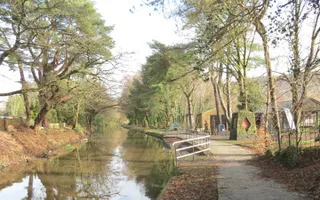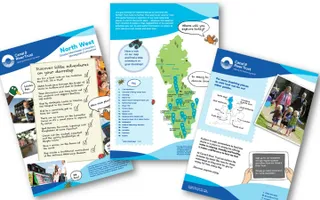Free guides for fun days out
Download our free guides - over 100 places to visit
The charity making life better by water
Making life better by water
While the Swansea Canal is no longer fully navigable it is still a green and pleasant walking and cycling route, nestled at the bottom of the steep-sided Swansea Valley.
Show me places within...
Explore your nearest canals and ways to enjoy them Find walks, activities and more within:
The Swansea Canal Society is working hard to restore the canal and it holds regular volunteering days.
The canal is now a popular trail and the towpath is part of the National Cycle Network although if you prefer paddles to wheels then Swansea Canal Society hires canoes and kayaks from Coed Gwilym Park, Clydach every Sunday in summer.
If you're in the area, a trip to the heritage centre in Coed Gwilym Park Clydach is a great way to familiarise yourself with the history of the canal. Open Saturday 11.00-3.00pm Sun 12.00–3.00pm.
Nature has reclaimed many parts of the canal, which are habitats for eels and water birds. So plans for restoration have been designed to protect both the canal's wildlife and its rich cultural heritage.
At the impressive Lower Clydach Aqueduct, you can see a grand meeting of the waters, where the canal joins with the Lower Clydach River and the River Tawe.
If you want to explore the River Tawe further the Swansea Community Boat Trust runs trips, which explain the rich industrial past of the Swansea Valley and Copperopolis.
The City of Swansea was known as 'Copperopolis' in the 18th and 19th centuries, indeed in 1820, 90% of all the copper-smelting capacity of Britain was based within twenty miles of the city and it was widely regarded as the world centre for copper-ore smelting and metal manufacturing and is one of the earliest industrial centres of Wales.
This industrial canal was built to serve collieries, iron works and copper works in the Tawe valley and the first section of the canal from Swansea to Godre'r-Graig was opened in 1796, and the whole length of 16.5 miles (26.6 km) was completed by October 1798. Civil engineering works included 36 locks and five aqueducts to carry the canal across major tributaries of the Afon Tawe, at Clydach, Pontardawe, Ynysmeudwy, Ystalyfera, and Cwmgiedd.
The canal had one curious feature: a central section just over a mile in length, was a private canal built by the Duke of Beaufort, which ran from Nant Rhydyfiliast to Nant Felin, on which the Duke was allowed to charge tolls. The Duke's section was called the Trewyddfa Canal, but was part of the main line.
The locks on the main section were 69 by 7.5 feet (21.0 by 2.3 m), but those on the Duke's section were only 65 feet (20 m) long, and this restricted the maximum length of boats. The locks raised the canal from near sea level at Swansea through 373 feet (114 m) to reach Abercraf.
At Swansea, wharfs were built alongside the river, where cargo could be transhipped into coasters. Unusually for such projects, the final cost was well within budget, with the project costing £51,602 up to mid-1798.
The opening of the canal caused an increase in industrial activity along the valley, with a number of manufacturing companies setting up works by its banks. Four short branch canals were constructed, and a network of tramways gradually linked mines and quarries to the canal.
There are few records of how much traffic was carried, but estimates based on the amount of coal and culm shipped from Swansea Docks suggest around 386,000 tons in 1839. The opening of the Tennant Canal to Swansea Docks in 1824 resulted in the Swansea Canal's riverside wharfs being improved.
The canal was bought by the Great Western Railway in 1873 for a price of £107,666 for the main Swansea Canal, and £40,000 for the Duke of Beaufort's Trewyddfa Canal and continued to be profitable until the mid-1890s. The last commercial traffic was in 1931, boats continued to operate on the canal after that date but only for maintenance work, with horse-drawn boats last recorded at Clydach in 1958.
In-filling of much of the canal has taken place in the past 50 years. The northern section was affected by the creation of the A4067 road around Ystradgynlais, while the southern section below Clydach had been infilled by 1982. In October 1998, after heavy rainfall a breach caused extensive flooding at Pontardawe, thirty houses, some industrial units and town centre shops were affected, with the water up to 4 feet (1.2 m) deep in places.
In 1981, the Swansea Canal Society was formed, and have been working towards restoration of the remaining sections of the canal. They have done much to improve the physical environment of the canal. A project is underway to dredge the canal and to remove the Japanese knotweed that grows extensively around the Swansea Valley.
We are very proud that for the second year running, the Swansea Canal has been awarded a prestigious Green Flag in Keep Britain Tidy's Award Scheme.

Sign up to our newsletter and discover how we protect canals and help nature thrive


